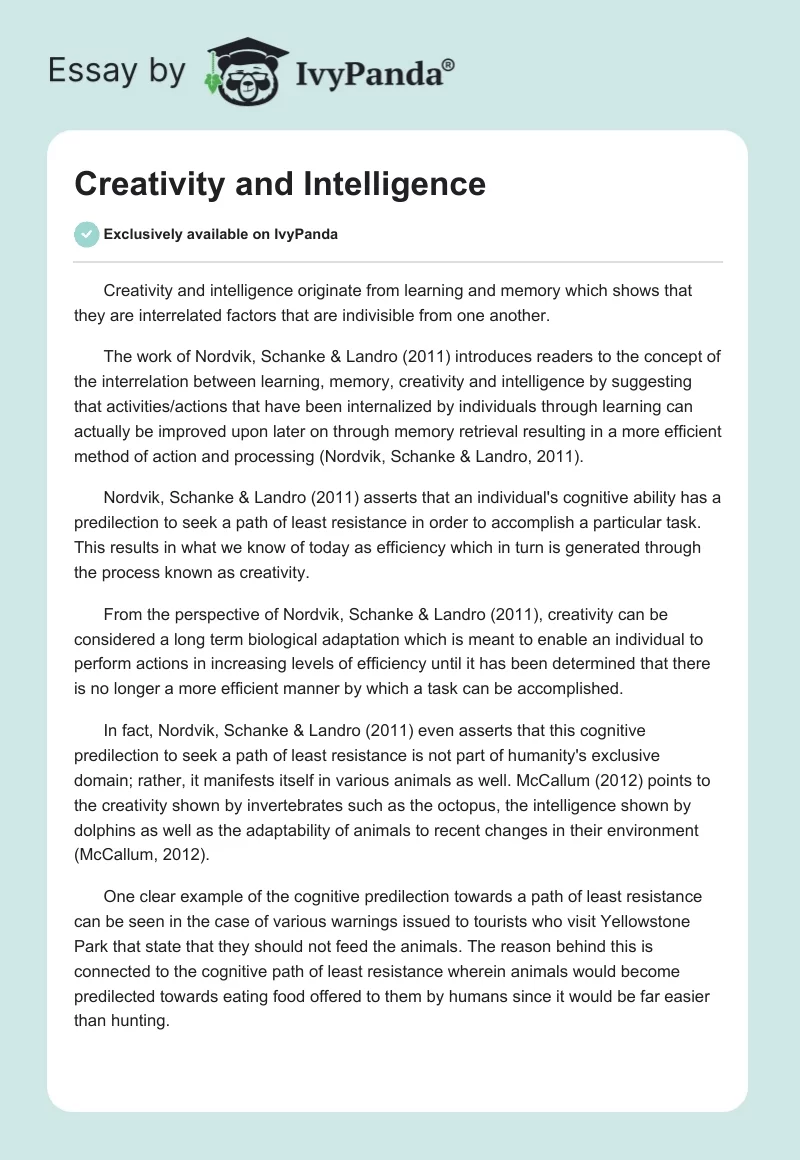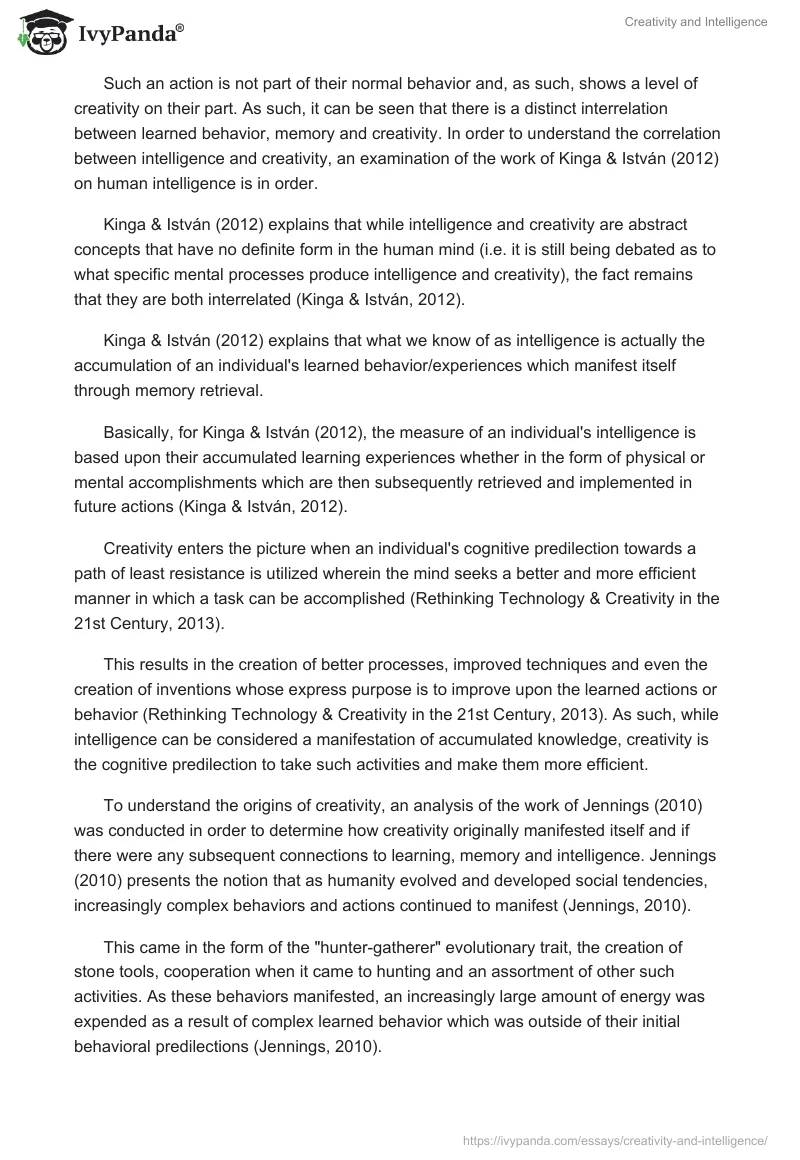Creativity and intelligence originate from learning and memory which shows that they are interrelated factors that are indivisible from one another.
The work of Nordvik, Schanke & Landro (2011) introduces readers to the concept of the interrelation between learning, memory, creativity and intelligence by suggesting that activities/actions that have been internalized by individuals through learning can actually be improved upon later on through memory retrieval resulting in a more efficient method of action and processing (Nordvik, Schanke & Landro, 2011).
Nordvik, Schanke & Landro (2011) asserts that an individual’s cognitive ability has a predilection to seek a path of least resistance in order to accomplish a particular task. This results in what we know of today as efficiency which in turn is generated through the process known as creativity.
From the perspective of Nordvik, Schanke & Landro (2011), creativity can be considered a long term biological adaptation which is meant to enable an individual to perform actions in increasing levels of efficiency until it has been determined that there is no longer a more efficient manner by which a task can be accomplished.
In fact, Nordvik, Schanke & Landro (2011) even asserts that this cognitive predilection to seek a path of least resistance is not part of humanity’s exclusive domain; rather, it manifests itself in various animals as well. McCallum (2012) points to the creativity shown by invertebrates such as the octopus, the intelligence shown by dolphins as well as the adaptability of animals to recent changes in their environment (McCallum, 2012).
One clear example of the cognitive predilection towards a path of least resistance can be seen in the case of various warnings issued to tourists who visit Yellowstone Park that state that they should not feed the animals. The reason behind this is connected to the cognitive path of least resistance wherein animals would become predilected towards eating food offered to them by humans since it would be far easier than hunting.
Such an action is not part of their normal behavior and, as such, shows a level of creativity on their part. As such, it can be seen that there is a distinct interrelation between learned behavior, memory and creativity. In order to understand the correlation between intelligence and creativity, an examination of the work of Kinga & István (2012) on human intelligence is in order.
Kinga & István (2012) explains that while intelligence and creativity are abstract concepts that have no definite form in the human mind (i.e. it is still being debated as to what specific mental processes produce intelligence and creativity), the fact remains that they are both interrelated (Kinga & István, 2012).
Kinga & István (2012) explains that what we know of as intelligence is actually the accumulation of an individual’s learned behavior/experiences which manifest itself through memory retrieval.
Basically, for Kinga & István (2012), the measure of an individual’s intelligence is based upon their accumulated learning experiences whether in the form of physical or mental accomplishments which are then subsequently retrieved and implemented in future actions (Kinga & István, 2012).
Creativity enters the picture when an individual’s cognitive predilection towards a path of least resistance is utilized wherein the mind seeks a better and more efficient manner in which a task can be accomplished (Rethinking Technology & Creativity in the 21st Century, 2013).
This results in the creation of better processes, improved techniques and even the creation of inventions whose express purpose is to improve upon the learned actions or behavior (Rethinking Technology & Creativity in the 21st Century, 2013). As such, while intelligence can be considered a manifestation of accumulated knowledge, creativity is the cognitive predilection to take such activities and make them more efficient.
To understand the origins of creativity, an analysis of the work of Jennings (2010) was conducted in order to determine how creativity originally manifested itself and if there were any subsequent connections to learning, memory and intelligence. Jennings (2010) presents the notion that as humanity evolved and developed social tendencies, increasingly complex behaviors and actions continued to manifest (Jennings, 2010).
This came in the form of the “hunter-gatherer” evolutionary trait, the creation of stone tools, cooperation when it came to hunting and an assortment of other such activities. As these behaviors manifested, an increasingly large amount of energy was expended as a result of complex learned behavior which was outside of their initial behavioral predilections (Jennings, 2010).
Given the conditions at the time, increasingly efficient methods of action were preferred since it would result in better energy conservation. It is based on this that Jennings (2010) asserts that there is an early connection between creativity and learned behavior wherein creativity manifested based on a need to create better and more efficient actions.
Further research on the topic yielded the research of Hetland (2013) on the interconnection between memory, learning and creativity. Hetland (2013) has an interesting view on this paper’s topic when he explains that creativity is the application of learned behavior which is retrieved through memory (Hetland, 2013).
Hetland (2013) asserts that when memory is retrieved through various retrieval mechanisms, it is actually compared by a central controller to memories within other storage areas. Through this shared pool of experience and comparison, possible methods of more efficient action are derived resulting in what we know as the present day creative process.
Basically, learned behavior from other stored memories are compared in order to see whether particular actions or behaviors can be applied to a process to make it more efficient. Through such a principle, it can be assumed that the more accumulated learned behaviors a person has, the more they are able to be creative in order to enhance particular actions or resolve problems as they arise.
A study from Ayob et al. (2012) backs up this claim by comparing creativity among children by asserting that the origin behind a child’s creativity in creating more efficient actions or resolving particular problems was the amount of learning experiences they had by which they could derive a comparison (Ayob et al., 2012).
Ayob et al. (2012) stated that the “root” of creativity so to speak was based on an individual’s accumulated learning experiences. Memory itself was not a sufficient means of eliciting creativity since Ayob et al. (2012) stipulates that it is in the amount of experiences that an individual has and not the means by which it is retrieved that is the basis behind the mechanisms of creativity.
Complexity Theory and Adult Learners
From the examples that have been presented, it can be assumed that the capacity for all individuals to learn, memorize, be creative and utilize their intelligence changes as they get older. This is due to the manner by which they accumulated experiences changes the manner in which they are intelligent and creative.
In the article “A Child of Complexity Theory: by Hase and Kenyon (2007), readers are introduced to the term “heutagogy” which concerns itself with the concept of “learners as the major agents of their own learning”.
In essence, complexity theory which is advocated for by Hase and Kenyon (2007), explains that an individual’s personal experiences determines the means by which they internalize and learn new pieces of information and it based on such experiences that each individual tends to learn the same type of lesson in different ways.
They state that it is a mistaken belief that teachers can control an individual’s learning experience; instead, a teacher is merely a means of transferring knowledge and skills with the personal experiences of the learner determining how their learning experience is created.
It is based on this that Hase and Kenyon (2007) make the assumption that what is necessary in modern day curriculums is not a set standard as determined by the educational institution, rather, what is necessary is the development of a “living” curriculum that centers itself on the experiences of the learner as the key driver towards education.
This means that a certain level of adjustment needs to be taken into consideration based on the learner wherein it is under their prerogative that the process of learning is implemented.
This can be accomplished by providing them choices as to the type of method of education they want (i.e. traditional, online, blended learning etc.) as well as involving them in methods of application that utilize real life situations so as to evaluate them based on their unique individual applications of the lessons they have learned.
Based on the views of Hase and Kenyon (2007), the major flaw in present day methods of education is that they create a “mold” so to speak in which students are expected to conform in order to learn. However, as seen in the case of “heutagogy” this is a major mistake given that an individual’s personal experience dictates the most effective method for learning.
It is when an individual’s desire for self-directed learning clashes with the set models created by an educational institutional which often results in them dropping out of the course due to a lack of motivation in completing it since they are not learning in the way that they desire.
By implementing an educational system where there is a greater level of self-direction, this would most likely result in higher rates of course completion among adult learners since they would be able to learn in the way that they would be most comfortable with.
Conclusion
Based on the information that has been presented, it is recommended that present day methods of education adjust teaching models in such a way that they take into consideration diversified experiences.
This is due to an individual’s personal experiences determining the means by which they internalize and learn new pieces of information and it based on such experiences that each individual tends to learn the same type of lesson in different ways.
By adjusting present day teaching models on such a premise, it is possible to maximize a learner’s experience which would result in a greater likelihood that they would be able to implement their creative skills in a more effective fashion resulting in better grades.
Reference List
Ayob, A., Majid, R., Hussain, A., & Mustaffa, M. (2012). Creativity Enhancement Through Experiential Learning. Advances In Natural & Applied Sciences, 6(2), 94-99.
Jennings, K. (2010). Developing Creativity: Artificial Barriers in Artificial Intelligence. Minds & Machines, 20(4), 489-501.
Hase, S., & Kenyon, C. (n.d.). Heutagogy: A child of complexity theory. (2007). International Journal of Complexity & Education, 4(1), 111-117.
Hetland, L. (2013). Connecting Creativity to Understanding. Educational Leadership, 70(5), 65.
Kinga, S., & István, S. (2012). Relationship between Social Creativity and Social Intelligence, and their Cognitive Correlates. Transylvanian Journal Of Psychology, 13(1), 39-62.
McCallum, A. (2012). The Creativity of Re-creativity. English Drama Media, (24), 23-29.
Nordvik, J. E., Schanke, A., & Landro, N. I. (2011). Errorless learning and working memory: The impact of errors, distractors, and memory span load on immediate recall in healthy adults. Journal Of Clinical & Experimental Neuropsychology, 33(5), 587-595.
Rethinking Technology & Creativity in the 21st Century. (2013). TechTrends: Linking Research & Practice to Improve Learning, 57(3), 10-14


